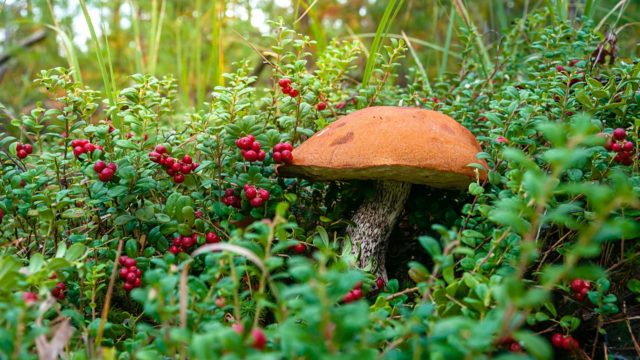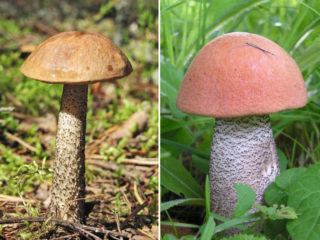Content
Mushrooms spoil very quickly, so it is necessary to clean boletus and boletus mushrooms as quickly as possible. To make the desired dish tasty, you need to properly prepare forest fruits.
How to wash boletus mushrooms
It is not recommended to wash the collected mushrooms immediately, as this will complicate the further cleansing process. First, the redheads are properly cleaned, removing all dirt and cutting out areas that have been worn down by worms. Then the fruits are cut into pieces and immersed in cold water for half an hour to protect them from darkening. For every liter of water add 20 g of salt. After this, the crop is washed under running water. If whole mushrooms are used for further preparation, then it is better to pick up each specimen and wash it separately. This way, cleaning will be more effective, and the pulp will not have time to absorb excess moisture.
If you need to preserve the beautiful appearance of boletuses or there is a possibility that a stream of water will damage the mushroom pulp, then use a more gentle method. To do this, fill a wide and preferably high basin with more water.Add the prepared mushrooms and mix them gently by hand. Then the liquid is drained, water is added again and the cleaning process is repeated two more times.
You can also place the sorted and peeled boletuses in a colander and completely immerse them several times in a bowl of water. Drain the liquid and, after filling again, rinse in the same way.
It is necessary to wash forest fruits quickly so that the caps do not absorb unnecessary moisture, which will spoil the taste of the boletus.
Do aspen mushrooms need to be cleaned?
Boletuses and boletuses are elite species, therefore, in order to preserve their taste, it is necessary to clean them properly.
Experienced mushroom pickers know that forest fruits must first be cleaned in the forest. Therefore, they always go on a quiet hunt with a knife. Before throwing the find into the basket, remove any remaining soil, adhering leaves and branches. Trim off the wormy pulp. If this is not done, the worms will eat the neighboring fruits.
For large specimens, cut the cap in half and look at the condition of the pulp. If it is severely damaged by worms, then such a mushroom is immediately thrown away.
Mature mushrooms have a loose sponge that is removed on site. If you leave it, it will stick to the caps of neighboring boletuses, which in the future will significantly complicate cleaning. Rotten and too old specimens are immediately thrown away, since the taste of such fruits is very low, and during transportation they turn into a shapeless slippery mass.These are the basic principles of preliminary preparation of boletuses in the forest; the rest of the work is already done at home.
Unprocessed forest fruits can be stored for a maximum of six hours from the moment they are collected. If you don’t have time to clean them right away, then you need to place them in a refrigerator or a cool room where the temperature does not rise above +4°C. The putrefactive process under such conditions will not develop so quickly and the crop will most likely be preserved.
Is it necessary to clean the legs of boletus mushrooms?
During the growth process, mushrooms absorb various types of pollutants found in the environment. Therefore, the legs of boletuses, as well as boletus mushrooms, must be cleaned.
Be sure to clean the boletus mushrooms for cooking, as unpeeled stems cause the broth to become dark and cloudy.
Is it necessary to clean the caps of boletus mushrooms?
Cleaning the caps of boletus mushrooms is a matter of taste for every mushroom picker. You won't be able to clean it with a regular knife. For this purpose, use a dry, lint-free cloth.
Under the cap is a spongy edible layer. It can be removed if desired or left for further preparation. But very often insects settle in its fibers and lay larvae. Therefore, experienced mushroom pickers most often remove it.
You can learn more about how to clean boletus from the video and detailed description below.
How to clean boletus mushrooms
The harvest of forest fruits is first sorted by size. Old specimens are separated from young ones. The stems are cut off from the caps, immediately checking for the presence of wormholes.
Then you need to decide what purposes the boletus will be used for, since their further preparation depends on this.
Processing of boletuses always begins with the stem. For this:
- cut off unnecessary base;
- if there are damaged areas, they are cut off. Also removes heavy dirt;
- The top layer is scraped off with a knife or cleaned with a small brush.
If there is a bountiful harvest of mushrooms, many mushroom pickers do not clean the stems. In this case, they are thoroughly washed and damaged areas are removed. Unpeeled black streaks on the surface of the stem do not affect the taste in any way.
The dark, insect-eaten pulp is removed from the caps. Use a slightly damp cloth to remove dirt. The skins of these mushrooms are not removed. The sponge of mature fruits must be cut off. This is due to the fact that it is in it that fungus gnats like to lay their larvae. The sponge also contains hard-to-digest spores, and when heat treated it becomes mucus-like.
How to properly clean boletus and boletus mushrooms, depending on the further cooking method:
- If you plan to dry forest fruits, then it is recommended to peel them only using the dry method. It is prohibited to wash them, let alone soak them. If the mushroom absorbs even a little moisture, it will not be possible to dry it. Clean the surface only with a dry cloth or small brush. For this method, only young, small specimens are selected that are not chipped by insects and have dense flesh;
- If you need to freeze the harvested crop, then you also cannot wash and soak the boletus. They will absorb moisture and when the temperature drops, the fibers will break, thereby deteriorating the quality of the workpiece. If boiled mushrooms are frozen, then carry out the usual processing;
- In boletuses and boletuses intended for frying, the skin must be cut off with a knife, since during the cooking process it becomes very hard, which negatively affects the quality of the dish.
If you need to preserve the harvested crop for as long as possible, without subjecting it to heat treatment, then the fruits are first washed. Then scald with boiling water and transfer to a glass container. Sprinkle each layer with salt and place on ice. This preparation allows you to preserve boletus mushrooms for a week. They are subsequently boiled or fried. The fruits are no longer suitable for drying and freezing.
Dry method
This method is used only with mushrooms intended for further freezing or drying:
- use a dry brush to remove clods of earth, leaves and small debris;
- heavily adhered debris from the caps is cleaned with a knife, since often a brush or sponge cannot cope with this task;
- the surface of the leg is scraped with a knife, removing the top layer;
- cut off eaten and damaged parts.
After this, large specimens are cut and further planned harvesting begins.
Is it necessary to soak boletus mushrooms?
To prevent the collected boletuses from darkening too quickly, you need to immerse them in slightly salted and always cold water. This method is only suitable for those specimens that do not plan to be dried and frozen.
If forest fruits need to be dried, then they cannot be soaked or even washed. Wet specimens take too long to dry and most often rot.
How long to soak boletus mushrooms
If the boletus is slightly wormy, you can soak it in water. To do this, add 40 g of salt to 1 liter of water, then pour the resulting solution into forest fruits for an hour. All worms and insects will leave the mushroom pulp during this time.
It is not always possible to easily remove contaminants from the surface of forest fruits. In this case, they are soaked in water. Half an hour is enough for the dirt to come off easily. But it is worth remembering that only strong and young specimens can be left. Old boletus and boletus absorb liquid well, which makes them limp.
You should not soak boletus mushrooms overnight, as they have a spongy structure that absorbs liquid abundantly. After this, they lose their high taste and density.
If the crop was harvested near highways or an industrial enterprise, then there is a high probability that the mushrooms contain hazardous metals and salts that they absorb from the soil. Experts recommend not collecting such specimens or, as a last resort, soaking them, but the process should not be lengthy. Maximum time is one hour. During the process, you need to change the water twice in order to clean the product as much as possible from the harmful substances contained in the composition.
If boletus and aspen mushrooms are collected in an ecologically clean place, deep in the forest or on the edges of the mushrooms away from the roadway, then there is no need for soaking, since the pulp of the mushrooms is not bitter.
Conclusion
It is imperative to clean boletus mushrooms; this is an important process in preparing mushrooms for further use. A high-quality procedure will provide the mushroom dish with an exceptional taste. At the same time, boletuses will turn into a holiday decoration, and will also provide the body with useful elements and vitamins.
















